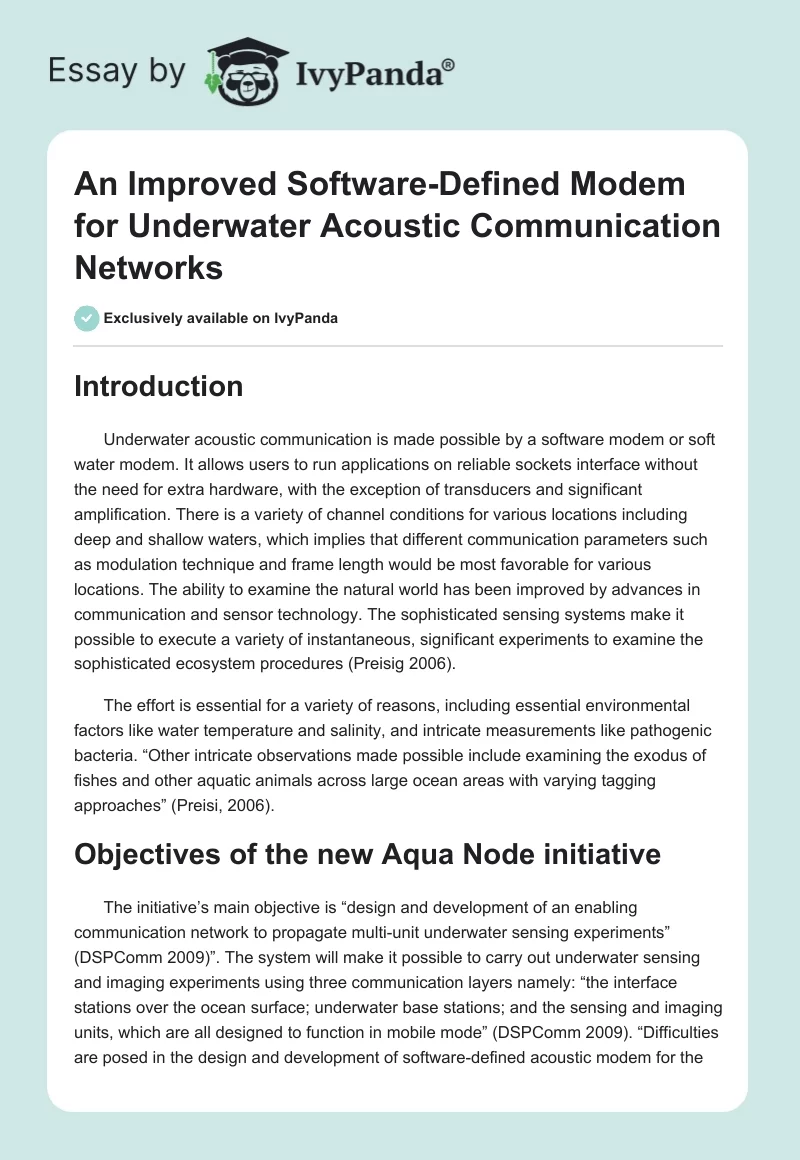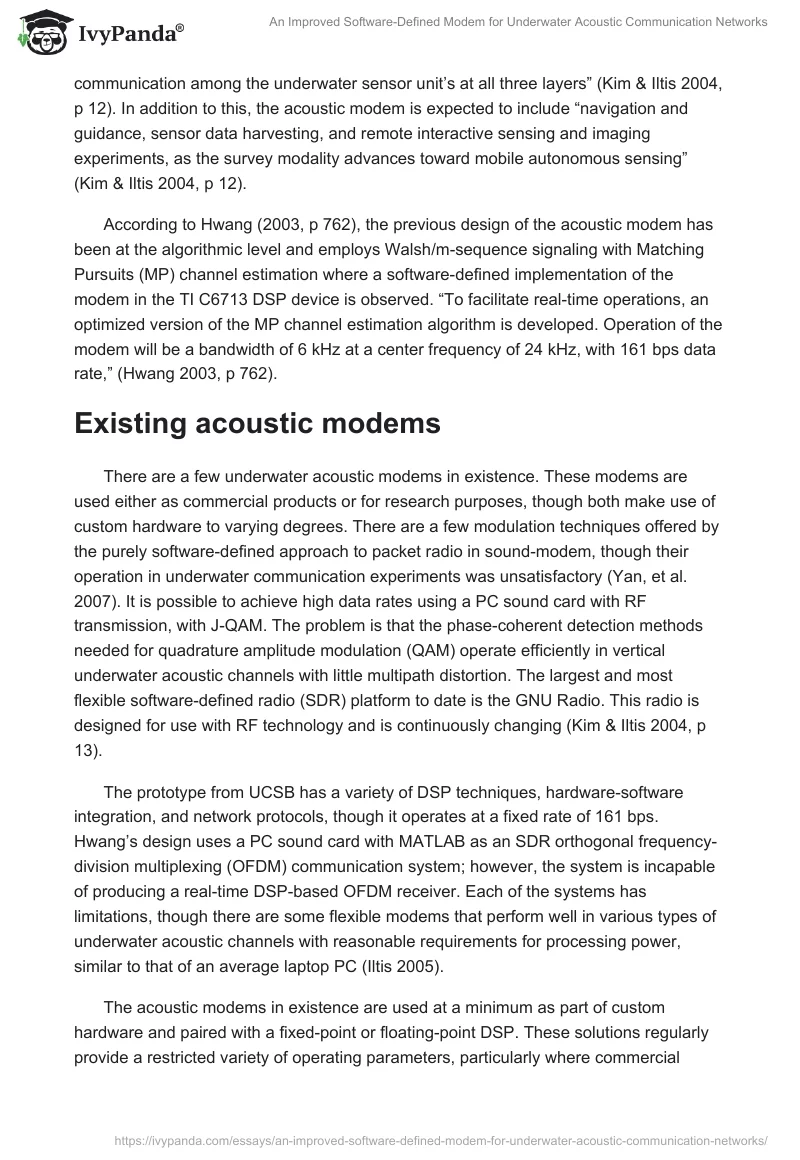Introduction
Underwater acoustic communication is made possible by a software modem or soft water modem. It allows users to run applications on reliable sockets interface without the need for extra hardware, with the exception of transducers and significant amplification. There is a variety of channel conditions for various locations including deep and shallow waters, which implies that different communication parameters such as modulation technique and frame length would be most favorable for various locations. The ability to examine the natural world has been improved by advances in communication and sensor technology. The sophisticated sensing systems make it possible to execute a variety of instantaneous, significant experiments to examine the sophisticated ecosystem procedures (Preisig 2006).
The effort is essential for a variety of reasons, including essential environmental factors like water temperature and salinity, and intricate measurements like pathogenic bacteria. “Other intricate observations made possible include examining the exodus of fishes and other aquatic animals across large ocean areas with varying tagging approaches” (Preisi, 2006).
Objectives of the new Aqua Node initiative
The initiative’s main objective is “design and development of an enabling communication network to propagate multi-unit underwater sensing experiments” (DSPComm 2009)”. The system will make it possible to carry out underwater sensing and imaging experiments using three communication layers namely: “the interface stations over the ocean surface; underwater base stations; and the sensing and imaging units, which are all designed to function in mobile mode” (DSPComm 2009). “Difficulties are posed in the design and development of software-defined acoustic modem for the communication among the underwater sensor unit’s at all three layers” (Kim & Iltis 2004, p 12). In addition to this, the acoustic modem is expected to include “navigation and guidance, sensor data harvesting, and remote interactive sensing and imaging experiments, as the survey modality advances toward mobile autonomous sensing” (Kim & Iltis 2004, p 12).
According to Hwang (2003, p 762), the previous design of the acoustic modem has been at the algorithmic level and employs Walsh/m-sequence signaling with Matching Pursuits (MP) channel estimation where a software-defined implementation of the modem in the TI C6713 DSP device is observed. “To facilitate real-time operations, an optimized version of the MP channel estimation algorithm is developed. Operation of the modem will be a bandwidth of 6 kHz at a center frequency of 24 kHz, with 161 bps data rate,” (Hwang 2003, p 762).
Existing acoustic modems
There are a few underwater acoustic modems in existence. These modems are used either as commercial products or for research purposes, though both make use of custom hardware to varying degrees. There are a few modulation techniques offered by the purely software-defined approach to packet radio in sound-modem, though their operation in underwater communication experiments was unsatisfactory (Yan, et al. 2007). It is possible to achieve high data rates using a PC sound card with RF transmission, with J-QAM. The problem is that the phase-coherent detection methods needed for quadrature amplitude modulation (QAM) operate efficiently in vertical underwater acoustic channels with little multipath distortion. The largest and most flexible software-defined radio (SDR) platform to date is the GNU Radio. This radio is designed for use with RF technology and is continuously changing (Kim & Iltis 2004, p 13).
The prototype from UCSB has a variety of DSP techniques, hardware-software integration, and network protocols, though it operates at a fixed rate of 161 bps. Hwang’s design uses a PC sound card with MATLAB as an SDR orthogonal frequency-division multiplexing (OFDM) communication system; however, the system is incapable of producing a real-time DSP-based OFDM receiver. Each of the systems has limitations, though there are some flexible modems that perform well in various types of underwater acoustic channels with reasonable requirements for processing power, similar to that of an average laptop PC (Iltis 2005).
The acoustic modems in existence are used at a minimum as part of custom hardware and paired with a fixed-point or floating-point DSP. These solutions regularly provide a restricted variety of operating parameters, particularly where commercial products are involved. The modem parameters are regularly selected depending on worst-case channel assumptions so that they can maximize the utility of the modem, and in so doing demand a series of products that are independently tailored to certain environments with varying depth, link distance, and expected severity of multipath. The development is logical though not the best, since flexible, optimized communication is especially important in the bandwidth-limited underwater environment (Pelekanakis, Stojanovic, & Freitag 2003, p 1096).
Hardware implementation
“The hardware of the underwater acoustic modem in implementation today is a combination of a combination of commercial off-the-shelf systems like DSP evaluation board; systems assembled from standard components like amplifiers; and components custom-made to spec like the transducers,” (Preisig 2006). The electronic constituents are incorporated into custom circuit boards. Batteries are used to supply the system power in the field (Preisig 2006). When testing the modem, lead-acid secondary cells are used, since they do not require recharging while in the field, though alkaline primary cells are used for the actual production. During the tests, little signal processing is conducted in hardware, “while modulation and demodulation are digital, using passband to perform the analog-digital conversions” (Sözer & Stojanovic 2006). The only implementations in hardware are amplification and reconstruction filters, helping to reduce hardware cost and complexity while maximizing flexibility (Sözer & Stojanovic 2006).
The improved software-defined modem
Its replacement is an all-software acoustic modem for underwater operation, whose only necessary hardware components are cables, amplifiers, and transducers. Other duties are performed by either the software or hardware commonly found in a PC-like platform like the A/D conversion is performed by the sound card. This modem has the ability to sense and adapt to its environment within a short time span (T. Fu 2006). The mechanism functions by having a “sounding signal” to precede every packet, which is then used by the receiver to compute and apply the channel’s inverse impulse response to the modulated data signal that follows the sounding signal. This allows the receiver to mitigate channel distortion on a packet-by-packet basis. The modem, therefore, presents the user with the ability to manipulate its functionality by editing a text file bearing the name and value pairs. A lot of options are supported, such as the number of carriers, base frequency, payload size, symbols per second, and number of parity bytes to be used (T. Fu 2006).
Another advantage of the software modem besides its ability to adapt to channel conditions is that it is by far much less expensive than the hardware devices in use today, and it is also easily configurable. Modem parameters can be selected to match the environment, therefore avoiding worst-case assumptions and making communication more efficient. The software architecture also supports TCP/IP-based communication, though it is not optimal for the underwater channel. Applications use the popular sockets interface and run unaltered on top of our modem layer, any number simultaneously. The effect is as if an Ethernet had been replaced by a much lower acoustic channel (Tritech 2009).
Challenges in developing high performance underwater acoustic modems
These have been categorized into three main classes namely: lack of maturity in underwater acoustic communications technology at all levels of the communication stack, due to the sophisticated and dynamic nature of the underwater channel; spatially and temporally dynamic nature of the underwater acoustic channel, since high-performance communications cannot be achieved using the largely channel-specific processing techniques similar to those that evolved from radiofrequency and optical communications; and resources, since there is no expectation that the processing will get to a point of high maturity near-term operational need, therefore posing challenges in justifying the specific investment of the application (Sözer & Stojanovic 2006).
In addition to this, underwater acoustic communications technology is immature and there are numerous possibilities for advancements. The various acoustic channels demand noticeably varied modem functionality that varies from frequency selection, modulation, and error control coding type, to MAC layer and network routing algorithms. This helps in achieving optimal performance. The initiative in this area is vital and there are goals that have been set as drivers for the design of underwater acoustic modem including low-cost adaptability and upgradability, which helps to advance the evolution of the latest mathematical processing technology through field experimentation and validation of new algorithms, as well as assist in the aligning of operational capability with an evolving state-of-the-art in underwater acoustic communication; a path to progress to a device that is capable of changing functionality as new channels are encountered operationally; and a path for migration to an application-specific device that can be produced to serve the needs of specific operations more efficiently in terms of power, mass and volume, than the generic approach, after the maturity of the algorithms (Yan, et al. 2007).
References list
DSPComm. 2009, AquaComm: Underwater wireless modem. [2011].
Hwang, J. K. 2003, Innovative communication design lab based on PC sound card and Matlab: a software-defined-radio OFDM modem example, Proc. IEEE Int. Conf. on Acous-tics, Speech, and Signal Processing, vol. 3, pp. 761-764.
Iltis, R. A. 2005, An Underwater Acoustic Telemetry Modem for Eco-Sensing, Washington, D.C.: Proc. MTS/IEEE Oceans.
Kim, S., & Iltis, R. A. 2004, A Matching Pursuit/GSIC-Based Algorithm for DS-CDMA Sparse Channel Estimation, IEEE Signal Processing Letters , vol. 11, 12-15.
Pelekanakis, C., Stojanovic, M., & Freitag, L. 2003, High Rate Acoustic Link for Underwater Video Transmission, Proc. OCEANS 2003 , vol. 2, pp. 1091-1097.
Preisig, J. 2006, coustic Propagation Consideration for Under-water Acoustic Communications Network Development. Los Angeles: Proc. WUWNet’06.
Sözer, E., & Stojanovic, M. 2006, Reconfigurable Acoustic Mod-em for Underwater Sensor Networks, Los Angeles: Proc. WUWNet’06.
T. Fu, D. D. 2006, Design and Development of a Software-Defined Underwa-ter Acoustic Modem for Sensor Networks for Environmental and Ecological Researc, Washington, D.C.: Proc. OCEANS 2006.
Tritech. 2009, AM-300 Acoustic Modem, [2011].
Yan, H., Zhou, s., Shi, Z. J., & Li, B. 2007, A DSP Implementa-tion of OFDM Acoustic Modem, Mon-treal: Proc. WUWNet’07.


